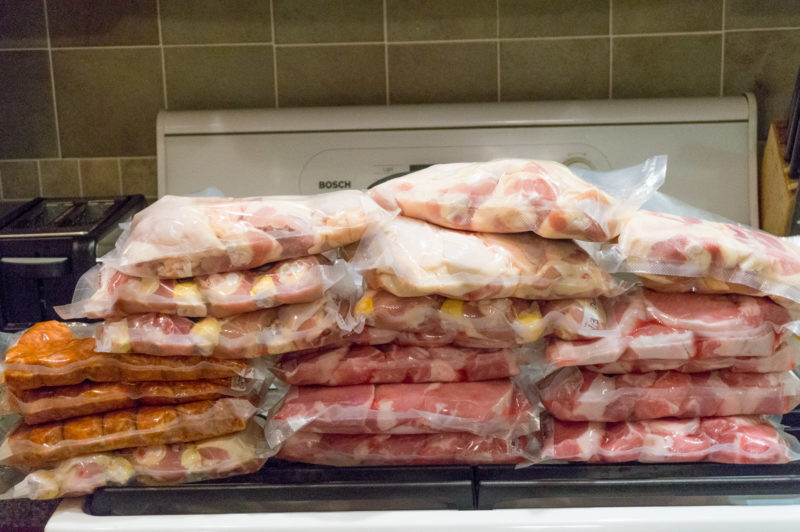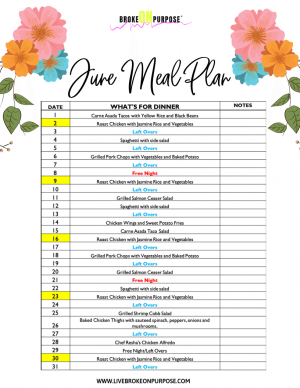This post contains affiliate links.
Can you agree that food is probably one of the biggest line items in anyone’s budget? Food can be downright expensive, especially if you have diet contains certain dietary restrictions. Many people even feel that eating healthy will increase their grocery budget by up to 30%. So how do you navigate between saving money and making sure that you’re eating nutritious meals?

Budgeting for groceries is an avoidable task, and finding that magic number on how much you need to realistically plan for spending each month can be like finding a needle in a haystack! The amount you spend on groceries is going to fluctuate based on if you’re single or buying for a family. It’s also going to vary based on your eating habits. Are you someone that likes simple, easy meals, or are you someone who likes to really throw down in the kitchen with all the herbs and spices? What’s your snacking routine? Do you meal plan? See how it can get overwhelming looking for that magic number?
One of the easiest ways to find your magic number for groceries is to average out how much you’ve spent over the last three months and then add 5%-10% for incidentals. My motto is to always over budget rather than under budget.
We typically spend $450 a month on groceries. This is just two people, but I love to cook. However, because we have some lofty financial goals this year, I decided to challenge myself and reduce our grocery bill by almost half! Yep, almost half. By incorporating these simple tips, we were successfully able to save almost 40% on our grocery bill last month and not go over budget. Read through them below and see how you can also incorporate these simple yet effective tips into your lives.
1. Consider what’s more important. Cash or Convenience?
In this crazy busy world, we often prescribe something with having more value if it also provides more convenience. Now you can order your groceries online via Amazon Fresh or even have them delivered or ready to be picked up curbside at your favorite grocery store on the way home. We want to get in an get out and in our rush to be faster we’re haphazardly leaving coins on the counter.
When you look at your grocery bill do you ever sometimes feel guilty about not taking advantage of savings by forgoing convenience? I know I used to, which is why I finally sat down and listened to my sister’s spill about how much money you can save by couponing. Sure, you can use coupons on AmazonFresh as well as with your Grocery delivery services, but these perks of convenience can keep you from maximizing your savings potential as not only are you charged a monthly fee and sometimes a delivery fee for using the service. Also, that particular store may not be offering the best deals on the items you’re purchasing.
Post to Read: True Life: I’ve become a Couponer
2. Do a Reconnaissance Mission.
If you’ve been shopping at only one store how do you know if the prices you’re paying are the best compared to other stores in the area? This is a dilemma I ran into once I started couponing. I couldn’t tell you if paying $1.79/lb for porkchop was good or not. I remember growing up listening to my aunt talk about the great deals being offered at various stores. She was a pro at knowing if something the store was offering was worth a trip. I decided that I was going to learn the ways of my Aunt. To do this, I went on a reconnaissance mission to our local BJ’s, since it was honestly the only place we shopped for groceries besides buying a few items here and there at the other smaller grocery stores.
With a pen and pad in hand (or you can use your phone note taking app), I walked throughout the store as if I was doing my regular grocery shopping. I wrote down the price per pound of all the meat we would purchase. I wrote down the cost of dry goods, and household items as well. Even though these things, like detergent or paper towels, were sold in bulk you can still break down the cost per pound, ounce, or roll by doing some quick math.
To save on vegetables, shop your local farmer’s markets or head to Aldi. Unless your vegan or a vegetarian refrain from purchasing more vegetables than you will you actually use so you won’t find yourself throwing away your hard earn cash with the rotten mushrooms you found pushed in the back of your refrigerator.
If you don’t shop at a big box warehouse store like Costco or BJ’s you can do still utilize this method by making a note of how much these items are at your local store on a day when they aren’t on sale.
3. Scope out the Weekly Circulars.
We all hate junk mail. How many of you just take all those flyers and throw them in your recycle bin? If you raised your hand, I want you to stop doing that right now! Those circulars are gold mines when it comes to saving money on your grocery bill.
Armed with the information you collected by doing the reconnaissance missions you are now able to efficiently do comparison shopping using the weekly grocery store or drug store flyers.
For example, If I knew that by shopping at BJ’s I’d spend $2.39/lb on center cut Pork Chops and my local grocery store had them on sale for $1.79, then that was savings of $0.60. If you shop in bulk like I do and buy at least 5-7 lbs, then you’re saving at minimum $3.
Another example of why you should do this would be when I paid $11 for a 5lb bag of Jasmine rice at our local grocery store due to “convenience” and then went to BJ’s a week later and saw a 25Lb of Jasmine rice for $16.00 with a $3 off coupon. Guess who was kicking themselves?
[ad name=”HTML”]4. C stands for Coins, and it also stands for Coupons!
I love to use my coupons and watch the price roll backward with each shopping trip. If you follow my IG stories, you may have seen the time I only paid $0.13for a purchase at CVS by using them. Now that you’ve planned your shopping trips don’t forget to add in your coupons to help you continue saving on your grocery bill.
Ever feel like you spend more time in the store then you really want? I honestly try not to spend longer than 20 minutes on any store visit, especially if I want to visit multiple stores. To do this, the day before I plan out where I want to go and determine if I have additional coupons I can use with the purchase. Using a simple coupon binder like this or this you can keep your coupons organized based on the shopping trip. There are also mobile coupons that can be used with apps SmartSource, Ibotta, and Coupons. You can really maximize coupon savings by taking advantage of BOGO deals or shopping at Walgreens and CVS.
5. Purchase a Deep Freezer
Okay, I’m asking you to spend a little more money here but seriously, if you can purchase a deep freezer do it! We’ve had our same one for over seven years, and it’s paid for itself over and over again. With a deep freezer, you can take advantage of great deals on poultry, seafood, and other meat items.
On a recent shopping trip, I took advantage of a deal on pork chops that was “Buy One Get Two Free.” After doing the math, this deal was still cheaper than purchasing at BJ’s. I walked out with six packs of boneless pork chop. That same store also had chicken on sale for $0.99/lb.
This whole haul of meat only cost me $67 and will get us through 20+ meals! When you count leftovers, this will hold us the entire month. All we need to do is add in our sides. We vacuumed sealed the bags using our favorite vacuum sealer to help preserve the meat in the freezer longer.

6. Do a Quick Scan of the Meat Section
Another great way to save money on your grocery bill is to not only pay attention to the weekly circulars but browse the meat sections on days when you’re doing a quick run to the grocery store to grab an item. Often grocery stores reduce the price of meat because it’s getting close to its “sell by date.” These purchases will typically have a sign that reads use or freeze immediately. I love to pick these up, separate them into portioned bags and of course, throw them in the deep freezer
By incorporating these tips into my shopping routine, we only spent a total of $241 out of our $275 grocery budget for February thus cutting our original grocery budget by around 35%. Sure this took some extra planning and a bit more time, but once all the work was done on the back end, everything else flowed seamlessly. We weren’t even confined to just eating rice and beans or crockpot meals (though I love a good Crock Pot Meal), by shopping the deals in the weekly circulars we able to take advantage of specials on lobster, at $5 a tail, and other more expensive seafood items.
Moving forward we’ll probably keep our grocery budget at around $275-$300 and use the extra $150 to $175 to fund something else or put towards our debt. If you have any other great tips for saving serious cash at the grocery store be sure to share your tips in the comments below!




We are a family of 3 (my husband is a powerlifter, and my 8 year old son eats as much as his dad sometimes!), and I have a grocery budget of $280/month, including household and personal items. I shop exclusively at Aldi. It is about 30 minutes away from our home, so I only go twice a month. I’ve broken our budget down into how much I will spend on each category ($25 meat, $15 dairy, etc). For our fruit and veggies, if we eat the outside, I buy organic if I can at all afford it. We usually do run out of fresh fruit before the next shopping trip, so I try to always have frozen fruit and veggies on hand. We normally eat a piece of fruit with our breakfast, so if we are out of fresh, I will blend some frozen strawberries with milk and we have “pink milk” (like on the Amazon prime kids show Charlie and Lola). Most of our suppers include meat, but not as the main entree. We do a lot of soups and stirfrys. Aldi has frozen wild caught salmon for $4 for 4 filets, which makes one meal for us when I add a bit of rice and some of my grandma’s canned green beans. We do have a meatless meal or two throughout the week. I used to spend $300/month but we too have some lofty financial goals, and sparkling water (among other things) felt like a luxury we could live without for a few months, so we can add that $20/month to our emergency fund. As for household and personal items, we go without or do homemade wherever possible. We go through maybe one roll of paper towels every other month, and just use rags most of the time. Cloth napkins. Real dishes and silverware. I purchase the rest of what we use from grove.com so I can make sure we are getting “green” products. My rough plan is to increase our grocery budget by about $50/month every year to account for increases in food prices and a soon to be tween then teen boy.
Word of mouth, couponing, and shopping clearance/store deals work for me! I have a lot of friends who coupon and let me know when they know of any match ups. It helps me a lot.
Word of mouth , couponing, and shopping clearance/store deals work for me! I have a lot of friends who coupon and let me know when they know of any match ups. It helps me a lot.